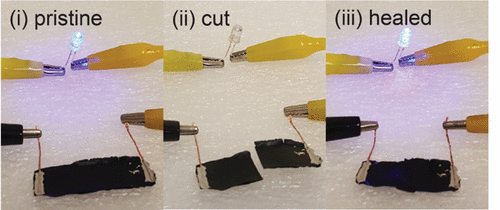当前位置:
X-MOL 学术
›
ACS Appl. Bio Mater.
›
论文详情
Our official English website, www.x-mol.net, welcomes your
feedback! (Note: you will need to create a separate account there.)
Highly Conductive Self-Healing Biocomposites Based on Protein Mediated Self-Assembly of PEDOT:PSS Films
ACS Applied Bio Materials ( IF 4.6 ) Pub Date : 2020-03-23 , DOI: 10.1021/acsabm.0c00207 Yusuke Kikuchi 1 , Abdon Pena-Francesch 1 , Mert Vural 1 , Melik C Demirel 1
ACS Applied Bio Materials ( IF 4.6 ) Pub Date : 2020-03-23 , DOI: 10.1021/acsabm.0c00207 Yusuke Kikuchi 1 , Abdon Pena-Francesch 1 , Mert Vural 1 , Melik C Demirel 1
Affiliation

|
Composites of conducting polymers offer a broad spectrum of materials for interfacing electronic devices with biological systems. Particularly, material systems based on poly(styrenesulfonate) doped poly(3,4-ethylenedioxythiophene) (PEDOT:PSS) have found applications in many bioelectronic devices as biosensitive transistors, controlled drug delivery media, and strain, temperature, and humidity sensors. The biocompatibility, intercoupled electronic and ionic conductivity, and air stable electrical properties render PEDOT:PSS based material systems indispensable for bioelectronics. However, these materials are commonly used in thin film form since freestanding films of pristine PEDOT:PSS are considered mechanically brittle compared to biological tissues, and unlike biological systems these conductive films cannot restore/heal their physical properties after excessive mechanical deformation. Here we report conductive biocomposites of PEDOT:PSS and tandem repeat proteins with the ability to self-heal once plasticized via water. The tandem repeat proteins acquired from squid ring teeth (SRT) induce structural effects on PEDOT:PSS including improved crystallinity and formation of fibrous network structures. These structural effects lead to electrical conductivity values reaching 120 S/cm for biocomposites with SRT protein concentrations below 20 wt %, which exceeds the conductivity of pristine PEDOT:PSS (∼100 S/cm). More importantly, tandem proteins facilitate consistent self-healing of freestanding biocomposites with SRT protein concentrations beyond 40 wt %. These robust biocomposites with high electrical conductivity and the ability to self-heal can find applications in numerous soft electronic systems spanning from implantable, transient, and epidermal electronics to electronic textiles.
中文翻译:

基于蛋白质介导的 PEDOT:PSS 薄膜自组装的高导电自愈生物复合材料
导电聚合物的复合材料为电子设备与生物系统的连接提供了广泛的材料。特别是,基于聚(苯乙烯磺酸盐)掺杂的聚(3,4-乙烯二氧噻吩)(PEDOT:PSS)的材料系统已在许多生物电子器件中发现应用,如生物敏感晶体管、受控药物输送介质以及应变、温度和湿度传感器。生物相容性、相互耦合的电子和离子电导率以及空气稳定的电性能使得基于 PEDOT:PSS 的材料系统对于生物电子学必不可少。然而,这些材料通常以薄膜形式使用,因为与生物组织相比,原始 PEDOT:PSS 的独立薄膜被认为是机械脆性的,与生物系统不同,这些导电薄膜在过度机械变形后无法恢复/修复其物理特性。在这里,我们报告了 PEDOT:PSS 和串联重复蛋白的导电生物复合材料,一旦通过水塑化,就具有自我修复的能力。从鱿鱼环齿 (SRT) 获得的串联重复蛋白对 PEDOT:PSS 产生结构影响,包括改善结晶度和形成纤维网络结构。这些结构效应导致 SRT 蛋白浓度低于 20 wt% 的生物复合材料的电导率值达到 120 S/cm,超过了原始 PEDOT:PSS 的电导率(~100 S/cm)。更重要的是,串联蛋白促进了 SRT 蛋白浓度超过 40 wt% 的独立生物复合材料的一致自愈。
更新日期:2020-04-23
中文翻译:

基于蛋白质介导的 PEDOT:PSS 薄膜自组装的高导电自愈生物复合材料
导电聚合物的复合材料为电子设备与生物系统的连接提供了广泛的材料。特别是,基于聚(苯乙烯磺酸盐)掺杂的聚(3,4-乙烯二氧噻吩)(PEDOT:PSS)的材料系统已在许多生物电子器件中发现应用,如生物敏感晶体管、受控药物输送介质以及应变、温度和湿度传感器。生物相容性、相互耦合的电子和离子电导率以及空气稳定的电性能使得基于 PEDOT:PSS 的材料系统对于生物电子学必不可少。然而,这些材料通常以薄膜形式使用,因为与生物组织相比,原始 PEDOT:PSS 的独立薄膜被认为是机械脆性的,与生物系统不同,这些导电薄膜在过度机械变形后无法恢复/修复其物理特性。在这里,我们报告了 PEDOT:PSS 和串联重复蛋白的导电生物复合材料,一旦通过水塑化,就具有自我修复的能力。从鱿鱼环齿 (SRT) 获得的串联重复蛋白对 PEDOT:PSS 产生结构影响,包括改善结晶度和形成纤维网络结构。这些结构效应导致 SRT 蛋白浓度低于 20 wt% 的生物复合材料的电导率值达到 120 S/cm,超过了原始 PEDOT:PSS 的电导率(~100 S/cm)。更重要的是,串联蛋白促进了 SRT 蛋白浓度超过 40 wt% 的独立生物复合材料的一致自愈。











































 京公网安备 11010802027423号
京公网安备 11010802027423号